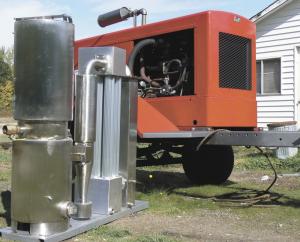2009 - Volume #33, Issue #6, Page #30
[ Sample Stories From This Issue | List of All Stories In This Issue | Print this story
| Read this issue]
Gasifier Is Your Own Personal Power Station
 |
The Oregon resident decided to use the one thing he had plenty of - wood - to create electricity by making wood gas to fuel a low-speed engine. The "Off Gridder" gasifier, as he calls it, uses a heat chamber with no oxygen to break wood down into its most basic elements - hydrogen, burnable carbon gases, and inert nitrogen.
Each morning Peterson loads his Off Gridder hopper with about 66 lbs. of small wood chunks. It feeds enough gas to an engine to charge a bank of batteries that meets the daily electricity needs for his house and shop - about 22 kwh/day.
Peterson first followed plans he got through the government's FEMA website to build the gasifier. It didn't work so he started experimenting - repeatedly - and modifying his own version.
"I started getting good results and knew this could be a viable energy solution for anyone with wood to burn," Peterson says. "So I set about developing a gasifier that would be easy to operate, easy to service, shippable, be multiple fuel capable and last a long time. Dozens and dozens of prototypes later, the Off Gridder is ready for market.
"For the very first firing you will want to run the unit for one to two hours just flaring the gas," Peterson explains. "This is done to break in the char zone and ensure the proper reactions are taking place. An air compressor is used to create vacuum that pulls air into the unit where it creates a very narrow zone of high heat. This hot carbon zone is responsible for turning the wood/biomass into fuel gas. Once the gas is clean, it's sent through the cooling and filtration system to the engine."
After the first use, start up time is just 3 to 5 min., Peterson says. Operation time varies according the fuel and hopper size. Off Gridder comes with a standard hopper that lasts about two hours and a larger hopper that runs for four hours. Peterson uses a standard hopper to meet his family's power needs.
He emphasizes that using the right fuel is key. Peterson uses mostly pine, cut into 1 to 2-in. blocks that are 20 percent moisture or less. Other waste materials include plum and cherry pits, nutshells, wood pellets, or corn.
"Operating a gasifier is like driving a car," he says. "It's a mystery at first, but once you have it figured out, it's a piece of cake. This isn't for people that want to sleepwalk through their push-button life."
The Off Gridder is intended for residential use, and not meant to run constantly. Peterson suggests using high amp items such as a washer, dryer and oven when the engine is running. The battery bank stores the energy for the rest of the day's electrical needs. If more power is needed, simply start up the gasifier again.
"The Off Gridder runs best with water-cooled cast iron 3, 4 or 6-cyl. low speed engines (1,800 rpm's)," Peterson says. "They're going to give you the best power, longevity and suction for proper operation. You can run stationary small block V-8 engines, too, but run time will be less. Pick up an old car engine and equip it with a truck alternator if you want to make DC power. Buy an old natural gas genset if you want to make AC power."
Waste heat from the engine can be used for hot water needs.
The Off Gridder starts at $4,900 and requires minimal assembly. Peterson says it's well built from stainless steel, carbon fiber gaskets, industrial grade motors, ceramic fiber insulation, dual wall construction, and thick flanges. "It's designed to be an heirloom quality power station that you can pass down through your family for generations," he says.
Peterson's website includes a Q&A page that includes many details about the Off Gridder.
Contact: FARM SHOW Followup, Ben Peterson, P.O. Box 367, Toledo, Wash. 98591 (ph 866 678-9232; www.woodygasifier.com).

Click here to download page story appeared in.

Click here to read entire issue
To read the rest of this story, download this issue below or click here to register with your account number.




